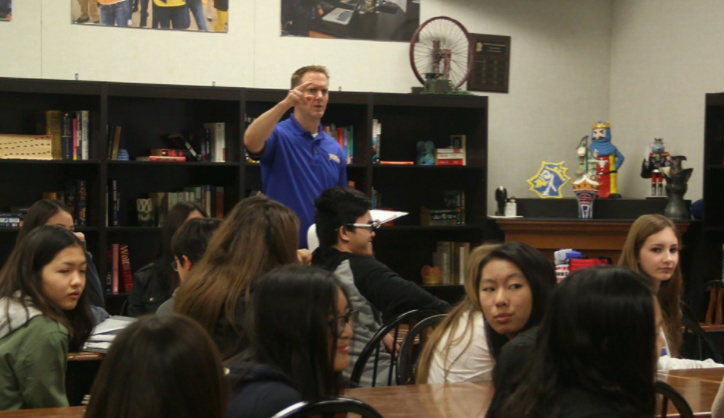
By Bethany Pham, News Editor & Ella Scott-Wallace, Staff Writer
Last month, multiple teachers evacuated their classrooms following complaints of a gas-like odor in the English and World Language halls. Spanish teacher Todd Yarnton and English teachers Steve Schultz and Rachael Woods relocated their classes to the faculty dining room and the media center.
Yarnton and English teacher Patricia Brewer are teaching at different sites on campus at the time of this publication.
“I usually smell a natural gas-like odor when I’m in Woods’ room,” said junior Vy Dang. “The last time I smelled it was on the Wednesday when we evacuated the class, and it was pretty strong. Luckily, it was near the time class ended, so we evacuated and left the hall.”
Since classrooms in the English halls were renovated in 2008, teachers and students have been reporting health issues after spending time in the affected classrooms.
“Affected English hall rooms are 122, 126, 127, 128, 129. In the World Language hall, the teachers in rooms 201, 202, 203, 205 and 206 have reported smelling a gas-like odor,” said Yarnton.
Due to the nature of the gas smell, teachers initially believed that the odors were products of a natural gas leak. Some common problems reported by students include headaches, inability to concentrate and vision problems. Teachers have reported cases of vertigo, sinus headaches and respiratory problems.
In 2011, the Huntington Beach Union High School District (HBUHSD) hired a certified industrial hygienist (CIH) to evaluate the heating, ventilation and air conditioning (HVAC) units.
Their findings concluded that poor ventilation of the building results in a buildup of carbon dioxide (CO2) and contaminants encompassing various odors, dust and allergens. More specifically, the CO2 sensors in classrooms aren’t regularly calibrated, and the fact that they are placed adjacent to the door could very well affect the sensors’ reading as a result of cross-draft from the hallway or outdoor air. The sensors have not been moved since the CIH’s initial report.
In a follow-up evaluation by the CIH, it was suggested that the exhaust from the units was being drawn into the air intake chamber, creating a cycle of producing exhaust that returns to the building. To correct this, the administration extended the exhaust stack.
“Extending the exhaust ports for the heating units didn’t work, though, because we are still getting the gas like odor,” said Yarnton.
But there are still other reasons that might connect the gas odors to the heating system. For the most part, FVHS experiences warm weather, and heaters aren’t activated. When heaters aren’t activated, principal Morgan Smith notes that the gas odors disappear, or teacher complaints do, at least.
“Every cold season, when our heaters kick on, our teachers will smell that smell of the exhaust,” said Smith. “Even if you have a brand new HVAC unit with the same placement and layout as other parts of campus that don’t experience these problems that should function perfectly, the design flaw could just be the geographics of the campus since the gas smell affects [classrooms in the southeastern corner of campus, those being] the 120s and then the low 200s. And if the wind hits the campus at that angle for those units and blows some of that heater exhaust back into intake, it might just be the area, so you might not have the same solutions.”
But some teachers don’t believe that the heaters are the root of the problem.
“In my class, the smell comes in even when the heat’s not on,” said Yarnton.
So, teachers still noticed the odors, and they’ve grown increasingly frustrated with the problem over time.
“Ten years with no solution, and the problems have gotten worse for a lot of us, so it’s just not okay; it’s not right,” said Schultz. “Every time they would say there’s nothing wrong, they would find a problem, then say it’s all good, but another problem would arise. Every time they would supposedly fix a problem, the gas odors would persist and the symptoms of the teachers never went away or decreased, unfortunately.”
Todd Yarton has sought medical care for his symptoms he believes are caused by the odors. He was put on restricted duty by his workers compensation doctor, which means he is not to teach in his classroom until the environmental issues have been resolved.
In response to teacher complaints last month, the district hired a new CIH to evaluate the school again, this being the third investigation that FVHS has conducted for the issue and the first of Smith’s tenure. The current process includes interviewing teachers to identify health concerns and reviewing when and where the gas-like odors have been reported. From there, the company will evaluate the HVAC unit, as well as the walls, floors and ceiling tiles. The completion of this process is scheduled for the end of February.
“Ultimately, we’ll make those fixes and adjustments,” said Smith. “Then, there will be the ongoing monitoring of those solutions to see if they really affect and improve what we smell and how we feel. When the heaters kick on and teachers smell that smell, if they are overwhelmed and don’t want to have that exposure or feel that way, we’re trying to be as accommodating as possible.”
Until then, teachers can only be hopeful that this more than decade-long issue can be resolved with.
“We know what the health issues have been for us,” said Yarnton. “We are concerned for the well-being of our students. We’re looking forward to finally finding out what is causing the symptoms and making sure that everyone on campus is safe.”
This article was originally published in the February 2019 issue of the Baron Banner.





